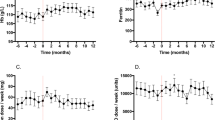Summary
Iron-dextran may be administered during haemodialysis by slow infusion through the venous access port for the management of iron deficiency in patients treated with erythropoietin. This technique is time-efficient and convenient. The degree to which haemodialysis removes iron-dextran in vivo, however, is unknown. The purpose of this study was to measure the removal of iron-dextran in patients undergoing haemodialysis. Eight patients were enrolled into this open label, single dose, mass transfer study. All were stable patients, treated by haemodialysis for at least 1 month and with a stable baseline average haematocrit of 30.9 ± 1.9%. All 8 patients used aTerumo® 175 cuprammonium dialyser and all received 1g of intravenous iron-dextran infused over 1 hour during dialysis. Dialysate was collected for an average of 160 ± 30 minutes, was concentrated by lyophilisation, and assayed for iron-dextran content by spectrophotometry. The amount of iron-dextran removed by haemodialysis was determined. Six of the 8 patients showed no detectable amounts of iron-dextran in the dialysate, while 2 showed less than 2% of the total dose given. Haemodialysis removed 5mg of iron during a 110-minute session in 1 patient, and 17mg of iron during a 188-minute session in a second patient. Both patients were dialysed with the Terumo® 175 dialyser, reprocessed once.
Our study concluded that there is minimal removal of iron-dextran by conventional haemodialysis in vivo. Administration of iron-dextran during haemodialysis is convenient and efficient, and does not warrant a change in dosage schedule.
Similar content being viewed by others
References
Magana L, Dhar SK, Smith EC, et al. Iron absorption and utilization in maintenance hemodialysis patients: oral and intravenous routes. Mt Sinai J Med 1984; 51: 180–3
Hollan S, Kirsten SJ. Adequate iron stores and the ‘Nil Nocere’ principle. Hematologia 1993; 25: 69–84
Kooistra MP, Van Es A, Struyvenburg A, et al. Iron metabolism in patients with the anaemia of end-stage renal disease during treatment with recombinant human erythropoietin. Br J Haematol 1991; 79: 634–9
Horl WH, Cavill I, Macdougall IC, et al. How to diagnose and correct iron deficiency during r-huEPO therapy — a consensus report. Nephrol Dial Transplant 1996; 11: 246–50
Skikne BS. Measuring iron dextran in serum: is it important? Clin Chem 1990; 36: 1711
Manuel MA, Stewart WK, St Clair-Neill GD, et al. Loss of iron dextran through a cuprophane membrane of a disposable coil dialyzer. Nephron 1972; 9: 94–8
Hatton RC, Portales I, Finlay A, et al. Removal of iron dextran by hemodialysis: an in-vitro study. Am J Kidney Dis 1995; 26: 327–30
Artiss JD, Vinogradov S, Zak B. Spectrophotometric study of several sensitive reagents for serum iron. Clin Biochem 1981; 16: 311–5
Author information
Authors and Affiliations
Rights and permissions
About this article
Cite this article
Bailie, G.R., Handa, J.J., Tang, L. et al. Minimal Removal of Iron-Dextran by Conventional Haemodialysis. Clin. Drug Investig. 14, 12–15 (1997). https://doi.org/10.2165/00044011-199714010-00002
Published:
Issue Date:
DOI: https://doi.org/10.2165/00044011-199714010-00002




